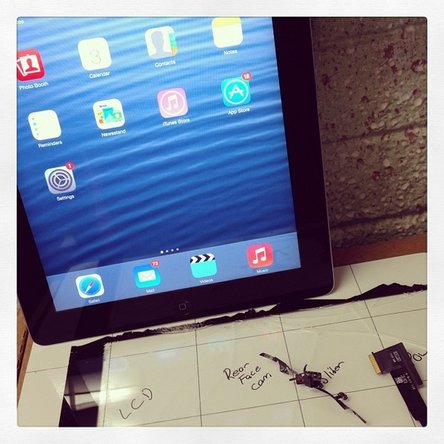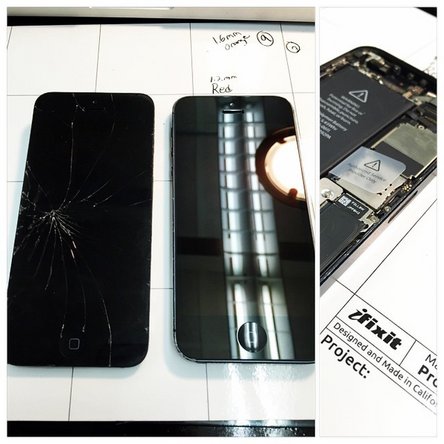Jason Kingsnorth, 25, does a bus-load of repairs. Like, a school bus-load.
He’s a Technology Aide/Coordinator at Bradley Schools in Bradley, Illinois—and half of the IT team that manages maintenance of the district’s technology fleet. All told, Jason helps keep 300 MacBook Pros, 250 iMacs, 150 PCs, and over 300 iOS devices running under what you might call … challenging circumstances (school kids, after all, can turn iPads into expensive juice boxes before you can say “recess”).
In the six years Jason has held the position, tech usage—both by students and teachers—has exploded. Every student now has easy access to iPads, and every classroom is equipped with a SMARTBoard and projector system. And that’s a good thing: modern technology affords students enormous benefits. According to the National Math + Science Initiative, integrated technology helps students stay focused on projects longer, it keeps them more engaged with challenging subject matter, it lets students learn at their own pace, and it better prepares graduates to enter the workforce.
But here’s the rub. Generally speaking, that tech isn’t indestructible and students aren’t exactly the gentlest of users. In 2012, a UK school district made international headlines when it was discovered that half of the 1,200 iPad 2s they bought were broken after just one year of student use.

With tight budgets and constant cuts, it’s just too expensive to replace a tablet every time the screen breaks. Those technology resources need to last for as long as they are still educationally useful. So, many schools have turned to internal repair teams as a way to balance the need for technology with the cost of maintenance.
We met Jason when he dropped a line on iFixit’s Facebook page to tell us about how his team was using iFixit guides and tools to fix tech in-house, instead of sending the devices out for expensive repairs. So, we dropped Jason a line—and asked him what life was like on the front lines of District 61’s war on obsolescence. Here’s what he said*:
(*answers have been edited for length and clarity)
Q: What’s your background in repair?
In the county where I live, during your junior year of high school you have the opportunity to attend Kankakee Area Career Center. Basically, they have different classes you can take to give you a head start to the career you would like in the future. I started in the Information Technology Class my junior year, and continued as a 2nd year student my senior year.
I was actually hired nearly straight out of high school at Bradley School District. I’ve always believed it was because I learned so much at Career Center, on top of what I already knew about the IT world.
Q: Tell us a bit about your district and how your repair program works.
Our district consists of five buildings at three locations. We employ over 250 staff members and we have roughly 1500+ technology assets currently. Every teacher has a MacBook Pro 13” (Mid-2012), a SMARTBoard, and projector in their room. Our kindergarten teachers each have five iPads for their classrooms. Pre-K has four iPads per classroom. In total, we have around 300 iOS devices. We have an iMac Lab of 30, two MacBook Pro 13” labs of 30 with another on its way, 2 PC Labs of 32 (soon to be replaced by Mac Mini’s) and every administrator has a MacBook Pro 15”.
Over the past 6 years we have seen a rise every year in the amount of Help Tickets we receive. In the 2010-11 school year, we had 637 Help Tickets. In 2011-12, we responded to 675. In the 2012-13 school year, we had 810. From 2013-14, we got 868. As of this school year … let’s just say within the first 2 weeks of school, we had almost 200 tickets. I’m expecting to break 1,000 Help Requests this year. With all of that being said … there are two of us in the Technology Department. It can be a struggle some days.

Q: What are some of the particular challenges of repairing for a school district?
One of the largest challenges in a school environment is the students. If you have a child at home and they are constantly messing with things on the computer or iPad, you know what I’m talking about. But just multiply that by 1,600. A good example of this is some students over the years have discovered that keys come off of keyboards and that you can spell out words on said keyboard.
Q: What’s the most common type of damage you see?
We tend to see a lot of accident damage with headphone jacks. The 3.5mm plug snaps off inside of the port and there’s basically no getting it out. In the last year, I’ve done over 20 of these repairs. There are some home remedies for getting the 3.5mm plug out that involve scissors, Bic Pens, super glue, toothpicks, needles, and so on—but I’ve never had one of those tricks work for me and I’m always skeptical about pouring super glue into a $400 iPad.
Q: A lot of school districts are struggling to keep their technology programs up to date, given nationwide budget cuts. Does the repair program help with that?
Before we started servicing our own iPads and fixing the issues ourselves, we would send them to Apple and have to pay a $200 exchange fee just to fix a broken headphone jack or dock connector. Now, with iFixit and doing our own repairs, we cut that price by nearly 90%. A headphone jack costs us around $13 to fix.
We are also a Apple Self Service Account (SSA), which gives me access to Apple’s repair website and is where we get our Mac parts and do warranty repairs in house. No more driving 45 minutes to the Apple store for this guy.

Q: Every tech has one—what’s your most epic repair story?
My boss and I have an inside joke that nothing ever happens here until he goes on vacation. Last year proved us correct. He was on vacation—the week was almost over and it had been terrible: finance server issues, phone system and phone line issues—all kinds of stuff that isn’t common.
8:05am, Friday: I walk into my office and the phone is already ringing, “We can’t connect to the WiFi”… Me: “Where can’t you?” … “The entire south end of the building.” So I get up to go check. The phone rings again. I answer it before I leave. “None of the computers in the lab have an internet connection.” Running through my mind was, “Okay, a switch died.” It’s pretty common when you have hundreds of switches, and we keep a spare at all times.
I walk into the room with our wiring rack and before I turn on the light, it’s completely silent (it is never good when no fans are on). All I hear is DRIP DRIP DRIP… I turn the light on, and there’s water everywhere.
The AC drain line for the computer lab on the floor below broke. It had been 90 degrees outside for two days, and the AC was running nearly non-stop. Let’s just say that the one spare switch we keep at all times … wasn’t enough. I think we did about $20,000 in damage. Strangely, my boss hasn’t gone on a long vacation during the school year since then.




0 opmerkingen